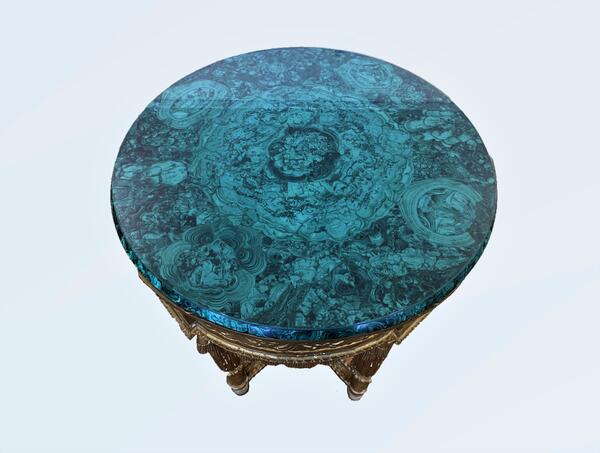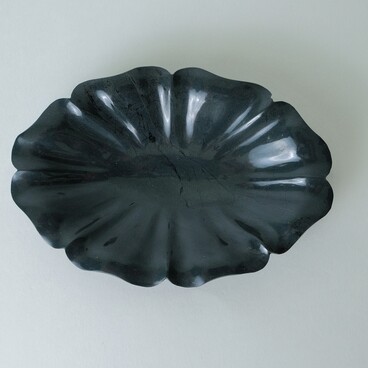A round table with a countertop made of Ural malachite is displayed in the center of the “Malachite Hall” of the Museum of Stone-Cutting and Jewelry Art History. Its lower part on four carved legs, the so-called “podstolye” (table support), was made later, presumably in the second half of the 20th century. At the same time, masters based the design on samples from the beginning of the 19th century. The carved details of the base are decorated with gilding.
The countertop is covered with a malachite mosaic with a symmetrical pattern: a large round rose is located in the center, while four small ones are on the edges.
The Russian type of opus sectile (tabular) mosaic was invented in the 18th century by masters of the Peterhof Lapidary factory, who worked on the interiors of Agate rooms in Tsarskoye Selo. Different minerals were used in this technique, but the most popular products were made of malachite.
The first malachite deposits at the Gumyoshevsky mine, the so-called Copper Mountain, were discovered back in 1702. At that time, the mineral did not have its familiar name: it was called ore or patterned stone. The term “malachite” first appeared in 1747 in a book by Swedish scientist Johan Gottschalk Wallerius.
Since 1749, the Gumyoshevsky mine was owned by industrialist Alexey Turchaninov. Large blocks of malachite were quite rare. That is why there were few big items made of it at that time. Small stones were used as inserts for jewelry, small boxes, compacts; also handles for cutlery were cut out of them.
The base for the works in the technique of Russian mosaic was made of metal or ornamental stone, for example, serpentine or marble. Then the master sawed the malachite into “stone plywood” — plates with a thickness of 2 to 4 millimeters — and arranged them so that a pattern formed. Ribbon-like and concentric drawings were very popular. The gaps between the plates were filled with crushed stone — a mixture of mastic, rosin, and crushed malachite.
The finished mosaic surface was polished with a special liquid. To get it, masters dissolved tin in nitric acid (it was called “strong vodka” in those times). The sediment was collected from this mixture, dried, ground into a fine powder, and then the finished stone item could be polished with it.
The countertop is covered with a malachite mosaic with a symmetrical pattern: a large round rose is located in the center, while four small ones are on the edges.
The Russian type of opus sectile (tabular) mosaic was invented in the 18th century by masters of the Peterhof Lapidary factory, who worked on the interiors of Agate rooms in Tsarskoye Selo. Different minerals were used in this technique, but the most popular products were made of malachite.
The first malachite deposits at the Gumyoshevsky mine, the so-called Copper Mountain, were discovered back in 1702. At that time, the mineral did not have its familiar name: it was called ore or patterned stone. The term “malachite” first appeared in 1747 in a book by Swedish scientist Johan Gottschalk Wallerius.
Since 1749, the Gumyoshevsky mine was owned by industrialist Alexey Turchaninov. Large blocks of malachite were quite rare. That is why there were few big items made of it at that time. Small stones were used as inserts for jewelry, small boxes, compacts; also handles for cutlery were cut out of them.
The base for the works in the technique of Russian mosaic was made of metal or ornamental stone, for example, serpentine or marble. Then the master sawed the malachite into “stone plywood” — plates with a thickness of 2 to 4 millimeters — and arranged them so that a pattern formed. Ribbon-like and concentric drawings were very popular. The gaps between the plates were filled with crushed stone — a mixture of mastic, rosin, and crushed malachite.
The finished mosaic surface was polished with a special liquid. To get it, masters dissolved tin in nitric acid (it was called “strong vodka” in those times). The sediment was collected from this mixture, dried, ground into a fine powder, and then the finished stone item could be polished with it.



